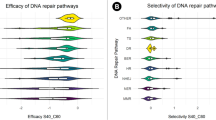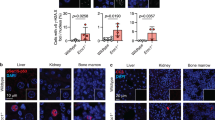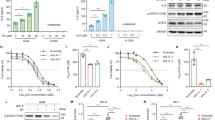Abstract
Cancer cells are defective in DNA repair, so they experience increased DNA strand breaks, genome instability, gene mutagenesis, and tumorigenicity; however, multiple classic DNA repair genes and pathways are strongly activated in malignant tumor cells to compensate for the DNA repair deficiency and gain an apoptosis resistance. The mechanisms underlying this phenomenon in cancer are unclear. We speculate that a key DNA repair gene or signaling pathway in cancer has not yet been recognized. Here, we show that the lipogenic liver X receptor (LXR)-sterol response element binding factor-1 (SREBF1) axis controls the transcription of a key DNA repair gene polynucleotide kinase/phosphatase (PNKP), thereby governing cancer cell DNA repair and apoptosis. Notably, the PNKP levels were significantly reduced in 95% of human pancreatic cancer (PC) patients, particularly deep reduction for sixfold in all of the advanced-stage PC cases. PNKP is also deficient in three other types of cancer that we examined. In addition, the expression of LXRs and SREBF1 was significantly reduced in the tumor tissues from human PC patients compared with the adjacent normal tissues. The newly identified LXR-SREBF1-PNKP signaling pathway is deficient in PC, and the defect in the pathway contributes to the DNA repair deficiency in the cancer. Strikingly, further diminution of the vulnerable LXR-SREBF1-PNKP signaling pathway using a small molecule triptonide, a new LXR antagonist identified in this investigation, at a concentration of 8 nM robustly activated tumor-suppressor p53 and readily elevated cancer cell DNA strand breaks over an apoptotic threshold, and selectively induced PC cell apoptosis, resulting in almost complete elimination of tumors in xenograft mice without obvious complications. Our findings provide new insight into DNA repair and apoptosis in cancer, and offer a new platform for developing novel anticancer therapeutics.
Similar content being viewed by others
Log in or create a free account to read this content
Gain free access to this article, as well as selected content from this journal and more on nature.com
or
Data availability
Available by request from the corresponding author or from commercial sources when applicable.
Change history
06 April 2020
A Correction to this paper has been published: https://doi.org/10.1038/s41418-020-0534-z
References
Khanna A. DNA damage in cancer therapeutics: a boon or a curse. Cancer Res 2015;75:2133–38.
Basu AK. DNA damage, mutagenesis and cancer. Int J Mol Sci. 2018;19:pii: E970.
Desai A, Yan Y, Gerson SL. Advances in therapeutic targeting of the DNA damage response in cancer. DNA Repair (Amst). 2018;66-67:24–9.
Toma M, Skorski T, Sliwinski T. DNA double strand break repair - related synthetic lethality. Curr Med Chem. 2019;26:1446–82.
Wright SM, Woo YH, Alley TL, Shirley BJ, Akeson EC, Snow KJ, et al. Complex oncogenic translocations with gene amplification are initiated by specific DNA breaks in lymphocytes. Cancer Res 2009;69:4454–60.
Waddell N, Pajic M, Patch AM, Chang DK, Kassahn KS, Bailey P, et al. Whole genomes redefine the mutational landscape of pancreatic cancer. Nature 2015;518:495–501.
Bailey P, Chang DK, Nones K, Johns AL, Patch AM, Gingras MC, et al. Genomic analyses identify molecular subtypes of pancreatic cancer. Nature 2016;531:47–52.
Liu IH, Ford JM, Kunz PL. DNA-repair defects in pancreatic neuroendocrine tumors and potential clinical applications. Cancer Treat Rev. 2016;44:1–9.
Osterman M, Kathawa D, Liu D, Guo H, Zhang C, Li M, et al. Elevated DNA damage response in pancreatic cancer. Histochem Cell Biol. 2014;142:713–20.
Miwa S, Yano S, Yamamoto M, Matsumoto Y, Uehara F, Hiroshima Y, et al. Real-time fluorescence imaging of the DNA damage repair response during mitosis. J Cell Biochem. 2015;116:661–66.
Cannon MV, van Gilst WH, de Boer RA. Emerging role of liver X receptors in cardiac pathophysiology and heart failure. Basic Res Cardiol. 2016;111:3.
Hsieh J, Koseki M, Molusky MM, Yakushiji E, Ichi I, Westerterp M, et al. TTC39B deficiency stabilizes LXR reducing both atherosclerosis and steatohepatitis. Nature 2016;535:303–7.
DeBose-Boyd RA, Ou J, Goldstein JL, Brown MS. Expression of sterol regulatory element-binding protein 1c (SREBP-1c) mRNA in rat hepatoma cells requires endogenous LXR ligands. Proc Natl Acad Sci USA. 2001;98:1477–82.
Kim K, Kim KH, Kim HH, Cheong J. Hepatitis B virus X protein induces lipogenic transcription factor SREBP1 and fatty acid synthase through the activation of nuclear receptor LXRalpha. Biochem J. 2008;416:219–30.
Li C, Yang W, Zhang J, Zheng X, Yao Y, Tu K, et al. SREBP-1 has a prognostic role and contributes to invasion and metastasis in human hepatocellular carcinoma. Int J Mol Sci. 2014;15:7124–38.
Sun Y, He W, Luo M, Zhou Y, Chang G, Ren W, et al. SREBP1 regulates tumorigenesis and prognosis of pancreatic cancer through targeting lipid metabolism. Tumour Biol. 2015;36:4133–41.
Villa GR, Hulce JJ, Zanca C, Bi J, Ikegami S, Cahill GL, et al. An LXR-cholesterol axis creates a metabolic co-dependency for brain cancers. Cancer Cell 2016;30:683–93.
Reynolds JJ, Walker AK, Gilmore EC, Walsh CA, Caldecott KW. Impact of PNKP mutations associated with microcephaly, seizures and developmental delay on enzyme activity and DNA strand break repair. Nucleic Acids Res. 2012;40:6608–19.
Nakashima M, Takano K, Osaka H, Aida N, Tsurusaki Y, Miyake N, et al. Causative novel PNKP mutations and concomitant PCDH15 mutations in a patient with microcephaly with early-onset seizures and developmental delay syndrome and hearing loss. J Hum Genet. 2014;59:471–74.
Chatterjee A, Saha S, Chakraborty A, Silva-Fernandes A, Mandal SM, Neves-Carvalho A, et al. The role of the mammalian DNA end-processing enzyme polynucleotide kinase 3’-phosphatase in spinocerebellar ataxia type 3 pathogenesis. PLoS Genet. 2015;11:e1004749.
Kalasova I, Hanzlikova H, Gupta N, Li Y, Altmuller J, Reynolds JJ, et al. Novel PNKP mutations causing defective DNA strand break repair and PARP1 hyperactivity in MCSZ. Neurol Genet. 2019;5:e320.
Gao R, Chakraborty A, Geater C, Pradhan S, Gordon KL, Snowden J, et al. Mutant huntingtin impairs PNKP and ATXN3, disrupting DNA repair and transcription. Elife 2019;8:e42988.
Mereniuk TR, El GMA, Mendes-Pereira AM, Lord CJ, Ghosh S, Foley E, et al. Synthetic lethal targeting of PTEN-deficient cancer cells using selective disruption of polynucleotide kinase/phosphatase. Mol Cancer Ther. 2013;12:2135–44.
Shire Z, Vakili MR, TDR M, Hall DG, AUID- Oho, Lavasanifar A, et al. Nanoencapsulation of novel inhibitors of PNKP for selective sensitization to ionizing radiation and irinotecan and induction of synthetic lethality. Mol Pharm. 2018;15:2316–26.
Chalasani SL, Kawale AS, Akopiants K, Yu Y, Fanta M, Weinfeld M, et al. Persistent 3’-phosphate termini and increased cytotoxicity of radiomimetic DNA double-strand breaks in cells lacking polynucleotide kinase/phosphatase despite presence of an alternative 3’-phosphatase. DNA Repair (Amst). 2018;68:12–24.
Smith AL, Alirezaie N, Connor A, Chan-Seng-Yue M, Grant R, Selander I, et al. Candidate DNA repair susceptibility genes identified by exome sequencing in high-risk pancreatic cancer. Cancer Lett. 2016;370:302–12.
Khan MA, Azim S, Zubair H, Bhardwaj A, Patel GK, Khushman M, et al. Molecular drivers of pancreatic cancer pathogenesis: looking inward to move forward. Int J Mol Sci. 2017;18:779–803.
Yoshikawa T, Shimano H, Yahagi N, Ide T, Amemiya-Kudo M, Matsuzaka T, et al. Polyunsaturated fatty acids suppress sterol regulatory element-binding protein 1c promoter activity by inhibition of liver X receptor (LXR) binding to LXR response elements. J Biol Chem. 2002;277:1705–11.
Kamisuki S, Shirakawa T, Kugimiya A, Abu-Elheiga L, Choo HY, Yamada K, et al. Synthesis and evaluation of diarylthiazole derivatives that inhibit activation of sterol regulatory element-binding proteins. J Med Chem. 2011;54:4923–27.
Chinison J, Aguilar JS, Avalos A, Huang Y, Wang Z, Cameron DJ, et al. Triptonide effectively inhibits wnt/beta-catenin signaling via c-terminal transactivation domain of beta-catenin. Sci Rep. 2016;6:32779.
Pan Y, Meng M, Zheng N, Cao Z, Yang P, Xi X, et al. Targeting of multiple senescence-promoting genes and signaling pathways by triptonide induces complete senescence of acute myeloid leukemia cells. Biochem Pharmacol. 2017;126:34–50.
Yang P, Dong F, Zhou Q. Triptonide acts as a novel potent anti-lymphoma agent with low toxicity mainly through inhibition of proto-oncogene Lyn transcription and suppression of Lyn signal pathway. Toxicol Lett 2017;278:9–17.
Han H, Du L, Cao Z, Zhang B, Zhou Q. Triptonide potently suppresses pancreatic cancer cell-mediated vasculogenic mimicry by inhibiting expression of VE-cadherin and chemokine ligand 2 genes. Eur J Pharm. 2018;818:593–603.
Zhang B, Meng M, Xiang S, Cao Z, Xu X, Zhao Z, et al. Selective activation of tumor-suppressive MAPKP signaling pathway by triptonide effectively inhibits pancreatic cancer cell tumorigenicity and tumor growth. Biochem Pharmacol 2019;166:70–81.
Fukuchi J, Kokontis JM, Hiipakka RA, Chuu CP, Liao S. Antiproliferative effect of liver X receptor agonists on LNCaP human prostate cancer cells. Cancer Res 2004;64:7686–89.
Lo SG, Bovenga F, Murzilli S, Salvatore L, Di TG, Martelli N, et al. Liver X receptors inhibit proliferation of human colorectal cancer cells and growth of intestinal tumors in mice. Gastroenterology 2013;144:1497–507.
Pommier AJ, Dufour J, Alves G, Viennois E, De Boussac H, Trousson A, et al. Liver x receptors protect from development of prostatic intra-epithelial neoplasia in mice. PLoS Genet 2013;9:e1003483.
Derangere V, Chevriaux A, Courtaut F, Bruchard M, Berger H, Chalmin F, et al. Liver X receptor beta activation induces pyroptosis of human and murine colon cancer cells. Cell Death Differ. 2014;21:1914–24.
Sharma B, Gupta V, Dahiya D, Kumar H, Vaiphei K, Agnihotri N. Clinical relevance of cholesterol homeostasis genes in colorectal cancer. Biochim Biophys Acta Mol Cell Biol Lipids. 2019;1864:1314–27.
Kim S, Lee M, Dhanasekaran DN, Song YS. Activation of LXRa/beta by cholesterol in malignant ascites promotes chemoresistance in ovarian cancer. BMC Cancer 2018;18:1232.
Wang K, Xu T, Ruan H, Xiao H, Liu J, Song Z, et al. LXRalpha promotes cell metastasis by regulating the NLRP3 inflammasome in renal cell carcinoma. Cell Death Dis. 2019;10:159.
Baek AE, Yu YA, He S, Wardell SE, Chang CY, Kwon S, et al. The cholesterol metabolite 27 hydroxycholesterol facilitates breast cancer metastasis through its actions on immune cells. Nat Commun 2017;8:864.
Shen Z, Zhu D, Liu J, Chen J, Liu Y, Hu C, et al. 27-Hydroxycholesterol induces invasion and migration of breast cancer cells by increasing MMP9 and generating EMT through activation of STAT-3. Environ Toxicol Pharm. 2017;51:1–8.
Marwarha G, Raza S, Hammer K, Ghribi O. 27-hydroxycholesterol: a novel player in molecular carcinogenesis of breast and prostate cancer. Chem Phys Lipids. 2017;207:108–26.
Zhang L, Liu M, Liu J, Li X, Yang M, Su B, et al. 27-Hydroxycholesterol enhanced osteoclastogenesis in lung adenocarcinoma microenvironment. J Cell Physiol. 2019;234:12692–700.
Zhao Y, Li H, Zhang Y, Li L, Fang R, Li Y, et al. Oncoprotein HBXIP modulates abnormal lipid metabolism and growth of breast cancer cells by activating the LXRs/SREBP-1c/FAS signaling cascade. Cancer Res 2016;76:4696–707.
Ji L, Zhang B, Zhao G. Liver X receptor alpha (LXRalpha) promoted invasion and EMT of gastric cancer cells by regulation of NF-kappaB activity. Hum Cell 2017;30:124–32.
Kim MJ, Choi MY, Lee DH, Roh GS, Kim HJ, Kang SS, et al. O-linked N-acetylglucosamine transferase enhances secretory clusterin expression via liver X receptors and sterol response element binding protein regulation in cervical cancer. Oncotarget 2018;9:4625–36.
Collins JL, Fivush AM, Watson MA, Galardi CM, Lewis MC, Moore LB, et al. Identification of a nonsteroidal liver X receptor agonist through parallel array synthesis of tertiary amines. J Med Chem. 2002;45:1963–66.
Houck KA, Borchert KM, Hepler CD, Thomas JS, Bramlett KS, Michael LF, et al. T0901317 is a dual LXR/FXR agonist. Mol Genet Metab. 2004;83:184–87.
Hu Y, Zang J, Cao H, Wu Y, Yan D, Qin X, et al. Liver X receptors agonist GW3965 re-sensitizes gefitinib-resistant human non-small cell lung cancer cell to gefitinib treatment by inhibiting NF-kappaB in vitro. Oncotarget. 2017;8:15802–14.
Ju X, Huang P, Chen M, Wang Q. Liver X receptors as potential targets for cancer therapeutics. Oncol Lett. 2017;14:7676–80.
Hiramitsu S, Ishikawa T, Lee WR, Khan T, Crumbley C, Khwaja N, et al. Estrogen receptor beta-mediated modulation of lung cancer cell proliferation by 27-hydroxycholesterol. Front Endocrinol (Lausanne). 2018;9:470.
Gibson DA, Collins F, Cousins FL, Esnal ZA, PTK S. The impact of 27-hydroxycholesterol on endometrial cancer proliferation. Endocr Relat Cancer. 2018;25:381–91.
Tian W, Pang W, Ge Y, He X, Wang D, Li X, et al. Hepatocyte-generated 27-hydroxycholesterol promotes the growth of melanoma by activation of estrogen receptor alpha. J Cell Biochem. 2018;119:2929–38.
Codini M, Cataldi S, Lazzarini A, Tasegian A, Ceccarini MR, Floridi A, et al. Why high cholesterol levels help hematological malignancies: role of nuclear lipid microdomains. Lipids Health Dis. 2016;15:4.
Jubinville E, Routhier J, Maranda-Robitaille M, Pineault M, Milad N, Talbot M, et al. Pharmacological activation of liver X receptor during cigarette smoke exposure adversely affects alveolar macrophages and pulmonary surfactant homeostasis. Am J Physiol Lung Cell Mol Physiol. 2019;316:L669–78.
Nelson ER, Wardell SE, Jasper JS, Park S, Suchindran S, Howe MK, et al. 27-Hydroxycholesterol links hypercholesterolemia and breast cancer pathophysiology. Science 2013;342:1094–98.
Porcelli L, Quatrale AE, Mantuano P, Leo MG, Silvestris N, Rolland JF, et al. Optimize radiochemotherapy in pancreatic cancer: PARP inhibitors a new therapeutic opportunity. Mol Oncol. 2013;7:308–22.
Karnak D, Engelke CG, Parsels LA, Kausar T, Wei D, Robertson JR, et al. Combined inhibition of Wee1 and PARP1/2 for radiosensitization in pancreatic cancer. Clin Cancer Res. 2014;20:5085–96.
Jin WH, Hoffe SE, Shridhar R, Strom T, Venkat P, Springett GM, et al. Adjuvant radiation provides survival benefit for resected pancreatic adenocarcinomas of the tail. J Gastrointest Oncol. 2018;9:487–94.
Srivastava P, Sarma A, Chaturvedi CM. Targeting DNA repair with PNKP inhibition sensitizes radioresistant prostate cancer cells to high LET radiation. PLoS ONE 2018;13:e0190516.
Zins M, Matos C, Cassinotto C. Pancreatic adenocarcinoma staging in the era of preoperative chemotherapy and radiation therapy. Radiology 2018;287:374–90.
Liu W, Meng M, Zhang B, Du L, Pan Y, Yang P, et al. Dehydroeffusol effectively inhibits human gastric cancer cell-mediated vasculogenic mimicry with low toxicity. Toxicol Appl Pharm. 2015;287:98–110.
Zhang B, Han H, Fu S, Yang P, Gu Z, Zhou Q, et al. Dehydroeffusol inhibits gastric cancer cell growth and tumorigenicity by selectively inducing tumor-suppressive endoplasmic reticulum stress and a moderate apoptosis. Biochem Pharmacol. 2016;104:8–18.
Liu W, Lv C, Zhang B, Zhou Q, Cao Z. MicroRNA-27b functions as a new inhibitor of ovarian cancer-mediated vasculogenic mimicry through suppression of VE-cadherin expression. RNA 2017;23:1019–27.
Yang P, Fu S, Cao Z, Liao H, Huo Z, Pan Y, et al. Oroxin B selectively induces tumor-suppressive ER stress and concurrently inhibits tumor-adaptive ER stress in B-lymphoma cells for effective anti-lymphoma therapy. Toxicol Appl Pharm. 2015;288:269–79.
Acknowledgements
This study was supported by grants from the National Natural Science Foundation of China (grants no. 81372376, no. 81572257, no. 81703595, and no. 81772535); Key Laboratory of Stem Cells and Biomedical Materials of Jiangsu Province and the Chinese Ministry of Science and Technology; State Key Laboratory of Radiation Medicine and Protection, School of Radiation Medicine and Protection; a project funded by the Priority Academic Program Development of Jiangsu Higher Education Institutions (PAPD); Jiangsu Province’s Key Discipline of Medicine (XK201118); the 2011 Collaborative Innovation Center of Hematology of Jiangsu Province; Natural Science Funds of Jiangsu Colleges and Universities (No. 16KJB310015); and Jiangsu Key Laboratory of Preventive and Translational Medicine for Geriatric Diseases. We thank Dr. Jian Zhou, Bowen Chen, Jiaqi Zheng, and Mingcheng Guan for collecting cancer patient samples and data.
Author information
Authors and Affiliations
Corresponding authors
Ethics declarations
Conflict of interest
The authors declare that they have no conflict of interest.
Additional information
Publisher’s note Springer Nature remains neutral with regard to jurisdictional claims in published maps and institutional affiliations.
Edited by T. Mak
Rights and permissions
About this article
Cite this article
Yang, B., Zhang, B., Cao, Z. et al. The lipogenic LXR-SREBF1 signaling pathway controls cancer cell DNA repair and apoptosis and is a vulnerable point of malignant tumors for cancer therapy. Cell Death Differ 27, 2433–2450 (2020). https://doi.org/10.1038/s41418-020-0514-3
Received:
Revised:
Accepted:
Published:
Issue date:
DOI: https://doi.org/10.1038/s41418-020-0514-3
This article is cited by
-
Unlocking the lipid code: SREBPs as key drivers in gastrointestinal tumour metabolism
Lipids in Health and Disease (2025)
-
Autocorrelation analysis of a phenotypic screen reveals hidden drug activity
Scientific Reports (2024)
-
Enhanced cancer cell proliferation and aggressive phenotype counterbalance in breast cancer with high BRCA1 gene expression
Breast Cancer Research and Treatment (2024)
-
Cancer/testis-45A1 promotes cervical cancer cell tumorigenesis and drug resistance by activating oncogenic SRC and downstream signaling pathways
Cellular Oncology (2024)
-
Mechanisms of obesity- and diabetes mellitus-related pancreatic carcinogenesis: a comprehensive and systematic review
Signal Transduction and Targeted Therapy (2023)



